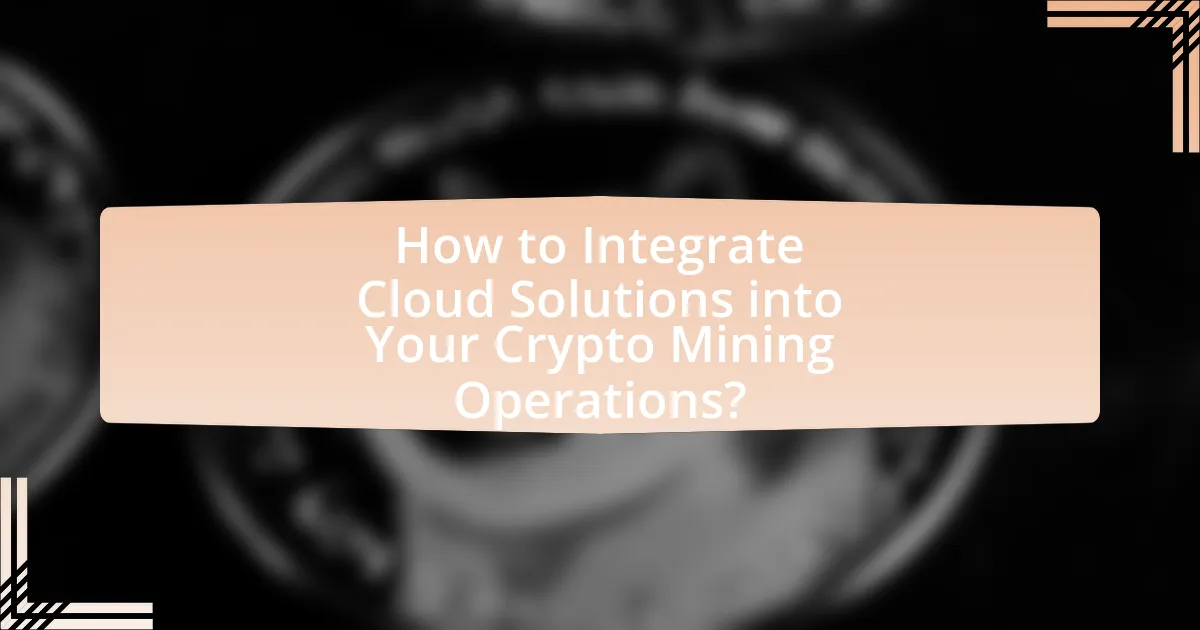Cloud solutions in crypto mining involve utilizing remote servers to conduct mining activities, allowing miners to access powerful computing resources without significant hardware investments. This article explores how cloud solutions enhance mining operations through scalability, cost-effectiveness, and improved computational power. It addresses the challenges faced by miners without cloud solutions, such as high upfront costs and limited scalability, and outlines the steps for integrating cloud solutions into mining operations. Additionally, it discusses the benefits of cloud mining, including reduced operational costs, increased energy efficiency, and strategies for maximizing profitability while ensuring security and data integrity.

What are Cloud Solutions in the Context of Crypto Mining?
Cloud solutions in the context of crypto mining refer to the use of remote servers hosted on the internet to perform mining activities instead of relying on local hardware. This approach allows miners to leverage powerful computing resources without the need for significant upfront investment in physical equipment. According to a report by ResearchAndMarkets, the global cloud mining market is expected to grow significantly, driven by the increasing demand for cryptocurrencies and the need for efficient mining solutions.
How do Cloud Solutions enhance Crypto Mining operations?
Cloud solutions enhance crypto mining operations by providing scalable computing power and reducing upfront hardware costs. These solutions allow miners to access vast resources on-demand, enabling them to adjust their operations based on market conditions and mining difficulty. For instance, cloud mining services can offer specialized hardware optimized for specific cryptocurrencies, which can lead to increased efficiency and profitability. Additionally, cloud solutions often include advanced management tools that streamline monitoring and maintenance, further improving operational efficiency.
What specific features of Cloud Solutions benefit Crypto Miners?
Cloud solutions benefit crypto miners through scalability, cost-effectiveness, and enhanced computational power. Scalability allows miners to adjust resources based on demand, enabling them to increase or decrease their mining capacity without significant upfront investment. Cost-effectiveness is achieved by reducing the need for physical hardware and maintenance, as miners can pay for only the resources they use. Enhanced computational power is provided through access to high-performance servers and advanced technologies, which can significantly increase mining efficiency and profitability. These features collectively enable crypto miners to optimize their operations and respond swiftly to market changes.
How do Cloud Solutions improve scalability in Crypto Mining?
Cloud solutions improve scalability in crypto mining by providing on-demand access to vast computational resources. This flexibility allows mining operations to quickly adjust their processing power based on market conditions and mining difficulty. For instance, cloud providers can offer scalable infrastructure that enables miners to increase or decrease their hash rate without the need for significant capital investment in hardware. According to a report by Deloitte, cloud-based mining services can reduce operational costs by up to 30%, allowing miners to scale operations efficiently while maintaining profitability.
What challenges do Crypto Miners face without Cloud Solutions?
Crypto miners face significant challenges without cloud solutions, primarily including high upfront costs, limited scalability, and increased operational complexity. Without cloud solutions, miners must invest heavily in physical hardware, which can be prohibitively expensive and requires ongoing maintenance. Additionally, scalability becomes a major issue, as miners cannot easily adjust their resources to meet fluctuating demands or increase their mining capacity. This inflexibility can lead to inefficiencies and lost opportunities in a rapidly changing market. Furthermore, managing mining operations without cloud solutions often involves complex logistics, including power management and cooling systems, which can be difficult to optimize without the advanced analytics and automation that cloud services provide.
How does hardware limitation affect Crypto Mining efficiency?
Hardware limitations significantly reduce crypto mining efficiency by restricting the processing power and speed necessary for solving complex cryptographic puzzles. For instance, older mining rigs may have lower hash rates, resulting in fewer successful transactions per second compared to modern ASIC miners, which can achieve hash rates exceeding 100 TH/s. This disparity means that miners with outdated hardware may take longer to mine the same amount of cryptocurrency, leading to decreased profitability. Additionally, hardware limitations can lead to increased energy consumption relative to the output, further diminishing overall efficiency.
What are the risks of traditional mining setups compared to cloud-based solutions?
Traditional mining setups face several risks compared to cloud-based solutions, primarily including high capital expenditure, maintenance challenges, and scalability issues. Traditional setups require significant upfront investment in hardware and infrastructure, which can lead to financial strain if market conditions fluctuate. Additionally, these setups demand ongoing maintenance and technical expertise, increasing operational costs and downtime risks. In contrast, cloud-based solutions offer flexibility and scalability, allowing miners to adjust resources based on demand without the burden of physical hardware management. This adaptability minimizes the risk of obsolescence and maximizes efficiency, as cloud providers often utilize the latest technology and infrastructure.

How to Integrate Cloud Solutions into Your Crypto Mining Operations?
To integrate cloud solutions into your crypto mining operations, first select a cloud service provider that specializes in high-performance computing and offers scalable resources. Providers like Amazon Web Services (AWS) and Google Cloud Platform (GCP) offer services tailored for crypto mining, enabling users to deploy virtual machines optimized for mining algorithms.
Next, configure the cloud infrastructure by setting up mining software on the virtual machines, ensuring that the software is compatible with the chosen cloud environment. This setup allows for efficient resource allocation and management, as cloud solutions can dynamically adjust to the mining workload.
Additionally, implement security measures such as firewalls and encryption to protect your mining operations from potential cyber threats. According to a report by the International Journal of Information Security, cloud environments can be vulnerable to attacks, making robust security protocols essential for safeguarding assets.
Finally, monitor performance and costs regularly to optimize mining efficiency and profitability. Utilizing cloud solutions can significantly reduce upfront hardware costs and provide flexibility in scaling operations based on market conditions.
What steps are involved in transitioning to Cloud-based Crypto Mining?
Transitioning to cloud-based crypto mining involves several key steps. First, assess your current mining operations to determine the feasibility and potential benefits of moving to the cloud. Next, select a reputable cloud mining provider that offers the necessary infrastructure, security, and scalability. After choosing a provider, set up an account and configure your mining parameters, including the type of cryptocurrency to mine and the desired hash rate. Subsequently, migrate your existing mining data and software to the cloud environment, ensuring compatibility with the provider’s platform. Finally, monitor the performance and costs associated with cloud mining to optimize your operations. This process is supported by the growing trend of cloud computing in the cryptocurrency sector, which has seen a significant increase in adoption due to its flexibility and reduced upfront costs.
How do you choose the right Cloud provider for Crypto Mining?
To choose the right cloud provider for crypto mining, evaluate factors such as performance, cost, scalability, and security. Performance is critical; select a provider that offers high computational power and low latency to maximize mining efficiency. Cost analysis should include not only the pricing model but also potential hidden fees related to data transfer and storage. Scalability is essential for adapting to changing mining demands; ensure the provider can accommodate growth without significant downtime. Security measures, including data encryption and compliance with regulations, are vital to protect your assets and operations. According to a report by Gartner, cloud services can reduce operational costs by up to 30%, making it a financially viable option for crypto mining.
What are the key considerations during the integration process?
The key considerations during the integration process of cloud solutions into crypto mining operations include compatibility, security, scalability, and cost-effectiveness. Compatibility ensures that the cloud infrastructure aligns with existing mining hardware and software, facilitating seamless integration. Security is critical, as sensitive data and assets must be protected against cyber threats; implementing robust encryption and access controls is essential. Scalability allows mining operations to adjust resources based on demand, optimizing performance and efficiency. Cost-effectiveness involves analyzing the total cost of ownership, including operational expenses and potential savings from cloud efficiencies. These considerations are vital for successful integration and long-term operational success.
What tools and technologies are essential for integration?
Essential tools and technologies for integration in crypto mining operations include cloud platforms, APIs, data integration tools, and orchestration software. Cloud platforms like Amazon Web Services and Microsoft Azure provide scalable infrastructure for mining operations. APIs facilitate communication between different software systems, enabling seamless data exchange. Data integration tools, such as Apache NiFi and Talend, allow for the aggregation and transformation of data from various sources. Orchestration software, like Kubernetes, manages containerized applications, ensuring efficient deployment and scaling of mining resources. These technologies collectively enhance operational efficiency and adaptability in cloud-based crypto mining environments.
How do APIs facilitate the integration of Cloud Solutions?
APIs facilitate the integration of Cloud Solutions by enabling seamless communication between different software applications and cloud services. They provide standardized protocols and tools that allow developers to connect their applications to cloud resources, ensuring data exchange and functionality across platforms. For instance, APIs allow crypto mining operations to access cloud computing resources for enhanced processing power, enabling real-time data analysis and resource management. This integration is crucial as it allows for scalability and flexibility, which are essential in the rapidly evolving crypto mining landscape.
What role do mining software and platforms play in the integration?
Mining software and platforms are essential for the integration of cloud solutions into crypto mining operations as they facilitate the management, optimization, and monitoring of mining activities. These tools enable miners to efficiently allocate resources, track performance metrics, and automate processes, which enhances operational efficiency. For instance, platforms like NiceHash and MinerGate provide user-friendly interfaces that allow miners to connect their hardware to cloud services, optimizing their mining capabilities based on real-time data and market conditions. This integration leads to increased profitability and reduced downtime, as evidenced by studies showing that miners utilizing cloud-based solutions can achieve up to 30% higher efficiency compared to traditional setups.

What are the Benefits of Using Cloud Solutions for Crypto Mining?
The benefits of using cloud solutions for crypto mining include reduced upfront costs, scalability, and enhanced accessibility. Cloud mining eliminates the need for significant hardware investments, allowing users to pay for mining power on a subscription basis, which can lower financial barriers. Additionally, cloud solutions offer scalability, enabling miners to adjust their computing power based on market conditions or personal needs without the hassle of managing physical equipment. Enhanced accessibility allows users to mine from anywhere with an internet connection, making it convenient for individuals who may not have the technical expertise or resources to set up their own mining rigs. These advantages contribute to a more efficient and user-friendly mining experience.
How do Cloud Solutions reduce operational costs for miners?
Cloud solutions reduce operational costs for miners by providing scalable resources that eliminate the need for expensive hardware investments and maintenance. By utilizing cloud infrastructure, miners can access powerful computing capabilities on-demand, which allows them to pay only for the resources they use, thus minimizing capital expenditures. Additionally, cloud solutions often include advanced analytics and monitoring tools that optimize mining operations, leading to increased efficiency and reduced energy consumption. For instance, a study by Deloitte found that companies leveraging cloud computing can reduce IT costs by up to 30%, which directly translates to lower operational costs for mining operations.
What are the long-term financial benefits of Cloud-based mining?
Cloud-based mining offers significant long-term financial benefits, primarily through reduced operational costs and increased scalability. By leveraging cloud infrastructure, miners can avoid the high upfront costs associated with purchasing and maintaining hardware, which can exceed thousands of dollars. Instead, they pay for mining power on a subscription basis, allowing for better cash flow management.
Additionally, cloud-based mining services often provide access to the latest technology and optimized mining algorithms, which can enhance profitability. For instance, a study by the Cambridge Centre for Alternative Finance indicates that cloud mining can yield higher returns due to lower energy costs and improved efficiency compared to traditional mining setups. This adaptability allows miners to scale operations up or down based on market conditions without incurring significant losses, further solidifying the financial advantages of cloud-based mining.
How does Cloud mining improve energy efficiency?
Cloud mining improves energy efficiency by utilizing centralized data centers that optimize power consumption and cooling systems. These facilities are designed to operate at maximum efficiency, often using renewable energy sources, which reduces the overall carbon footprint compared to individual mining operations. For instance, a study by the Cambridge Centre for Alternative Finance indicates that large-scale mining operations can achieve energy efficiencies of up to 50% compared to smaller, decentralized setups. This centralized approach allows for better resource management and lower operational costs, making cloud mining a more sustainable option in the cryptocurrency ecosystem.
What impact do Cloud Solutions have on mining performance?
Cloud solutions significantly enhance mining performance by providing scalable resources, real-time data analytics, and improved operational efficiency. These solutions enable miners to access powerful computing capabilities on-demand, allowing for increased processing power without the need for substantial upfront investment in hardware. For instance, cloud-based platforms can optimize mining operations by analyzing vast amounts of data to identify the most profitable mining strategies and adjust parameters dynamically. Additionally, a study by Deloitte in 2021 highlighted that companies utilizing cloud technologies in their mining operations reported a 20% increase in productivity due to better resource management and reduced downtime.
How do Cloud Solutions enhance mining speed and output?
Cloud solutions enhance mining speed and output by providing scalable computing resources and real-time data analytics. These solutions allow miners to access powerful processing capabilities on-demand, enabling them to handle complex calculations more efficiently. For instance, cloud platforms can dynamically allocate resources based on current mining demands, which optimizes performance and reduces downtime. Additionally, real-time analytics facilitate better decision-making by monitoring mining operations and adjusting strategies instantly, leading to increased productivity. Studies have shown that companies utilizing cloud computing in their mining operations can achieve up to a 30% increase in efficiency compared to traditional methods.
What metrics should be monitored to evaluate mining performance in the cloud?
To evaluate mining performance in the cloud, key metrics to monitor include hash rate, energy consumption, uptime, and profitability. The hash rate indicates the computational power being utilized for mining, directly affecting the number of successful transactions processed. Energy consumption is crucial as it impacts operational costs; efficient mining operations should aim for a low energy-to-hash rate ratio. Uptime measures the reliability of the cloud service, with higher uptime percentages indicating better performance and less downtime. Profitability assesses the overall financial return from mining activities, factoring in costs such as cloud service fees and electricity. Monitoring these metrics ensures optimal performance and cost-effectiveness in cloud-based mining operations.
What are the best practices for optimizing Cloud-based Crypto Mining?
The best practices for optimizing cloud-based crypto mining include selecting the right cloud provider, utilizing efficient mining algorithms, and implementing robust monitoring tools. Choosing a cloud provider with low latency and high uptime ensures better performance and reliability, which is crucial for maximizing mining efficiency. Employing efficient mining algorithms, such as those that are ASIC-friendly, can significantly enhance hash rates and reduce energy consumption. Additionally, using monitoring tools allows miners to track performance metrics in real-time, enabling quick adjustments to optimize operations. These practices collectively contribute to improved profitability and operational efficiency in cloud-based crypto mining.
How can miners ensure security and data integrity in the cloud?
Miners can ensure security and data integrity in the cloud by implementing robust encryption protocols and utilizing decentralized storage solutions. Encryption protects data both at rest and in transit, making it unreadable to unauthorized users. For instance, using AES-256 encryption can secure sensitive information effectively. Additionally, decentralized storage solutions, such as blockchain technology, provide redundancy and immutability, ensuring that data cannot be altered without consensus. This combination of encryption and decentralized storage not only safeguards against data breaches but also enhances the overall integrity of the data stored in the cloud.
What strategies can be employed to maximize profitability in Cloud mining?
To maximize profitability in cloud mining, investors should focus on selecting reputable cloud mining providers, optimizing contract terms, and monitoring market conditions. Choosing established providers with transparent pricing and reliable hardware ensures better performance and lower risks. Optimizing contract terms, such as selecting the right duration and hash rate, can significantly impact returns; for instance, longer contracts may offer lower rates per hash. Additionally, staying informed about cryptocurrency market trends allows miners to adjust their strategies, such as switching to more profitable coins or adjusting mining power based on market fluctuations. These strategies are supported by the fact that profitability in cloud mining is heavily influenced by operational efficiency and market dynamics.